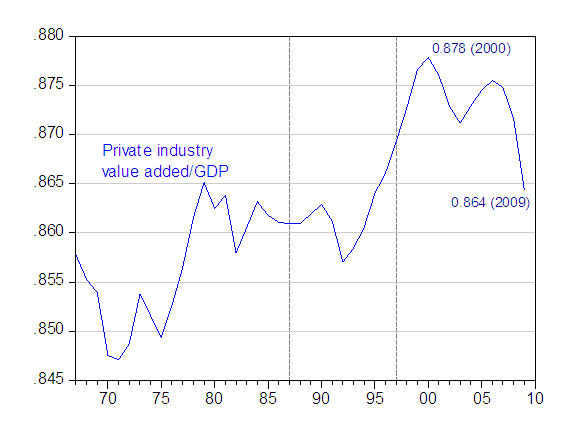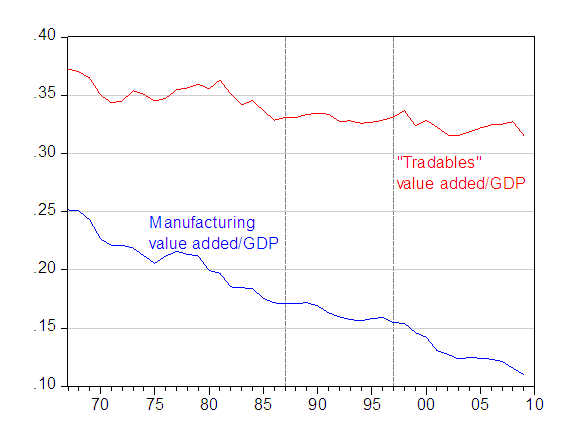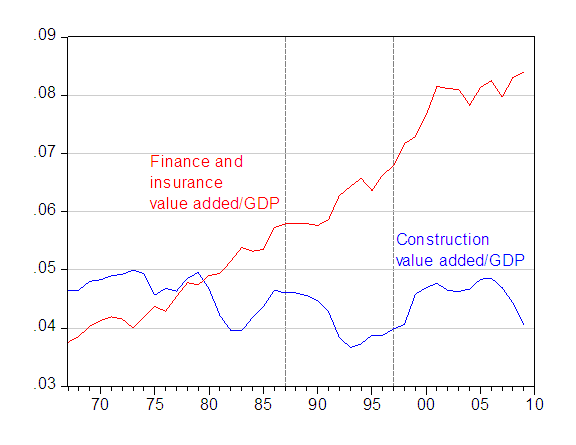The BEA today released value added and output series by industry through 2009. A few highlights: (1) the share of the private sector value added in total GDP has declined by 1.34 percentage points since 2000; (2) manufacturing’s share of GDP continues to decline in nominal terms; and (3) the share of finance and insurance barely rose in 2009.
The data highlight a number of trends that are relevant to issues currently debated in policy circles. One is the extent to which the government has encroached upon the private sectors, in terms of production. Figure 1 plots the value added of all private industries, divided by GDP.

Figure 1: Value added of all private industries expressed as a share of GDP. Dashed lines denote breaks in the data series. Source: BEA, GDP by industry data, release of 25 May 2010, and previous releases, and author’s calculations.
Notice that the recent decrease has only brought down the ratio to something more akin to the historical norm prevailing from 1965-95 (actually a bit above).
Next, what has happened to the economy in terms of reorienting output toward tradable goods, necessary as a prerequisite for increasing exports and decreasing imports? [1]

Figure 2: Value added of manufacturing (blue) and “tradables” (red) expressed as a share of GDP. “Tradables” defined as sum of manufacturing, mining, agriculture, and 70% of professional and business services. Dashed lines denote breaks in the data series. Source: BEA, GDP by industry data, release of 25 May 2010, and previous releases, and author’s calculations.
Clearly, manufacturing continues its decline as a share of GDP. There are a number of caveats to keep in mind. First, manufacturing is highly procyclical, and moves much more with GDP than other components of GDP. Hence, it would not be surprising to see a bounceback once data for a full year incorporating a period of recovery is included in the plot. Second, real output in manufacturing has almost assuredly not shown as much a decline. This is a drawback of using the value added share data; we cannot control for relative price effects.
Finally, we know that the set of tradables is broader than merely manufactured goods (see this post). I also plot a proxy measure for tradables which includes manufacturing, mining, agriculture and 70% of professional and business services. I would say that this series simultaneously overstates the level of tradables, and overstates the downward trend in the series. Clearly, less a much smaller share of professional and business services are exportable at the beginning of the sample shown than at the end, for instance.
Finally, there has been a lot of talk about job-mismatches and a potential increase in structural unemployment (or NAIRU). Here, I don’t have any specific information on the issue, but the data do provide a perspective on how the shares of two key sectors in the boom/bust cycle we’ve just suffered through have evolved.

Figure 3: Value added of construction (blue) and finance and insurance (red) expressed as a share of GDP. Dashed lines denote breaks in the data series. Source: BEA, GDP by industry data, release of 25 May 2010, and previous releases, and author’s calculations.
Construction’s share of value added certainly seems to have substantially decreased, back to 1998 levels. Finance and real estate have not shown a corresponding decrease. Of course, the denominator in all these ratios was GDP, so the trends are going to be obscured by the very large downturn in those years. However, presumably if financial reform proceeds, and incorporates more regulation (including higher capital requirements) and even taxes on assets or liabilities, then one should expect a change in the trend in the finance and insurance share of GDP. On this point, only time will tell.
Tales from the BEA’s GDP by Industry Release: The Private Economy and Rebalancing
- Bulenox: Get 45% to 91% OFF ... Use Discount Code: UNO
- Risk Our Money Not Yours | Get 50% to 90% OFF ... Use Discount Code: MMBVBKSM
Disclaimer: This page contains affiliate links. If you choose to make a purchase after clicking a link, we may receive a commission at no additional cost to you. Thank you for your support!



Leave a Reply